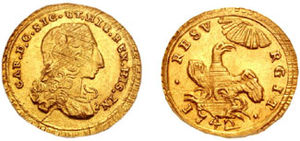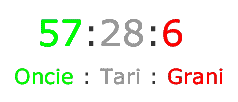San Giovanni in Fiore - Catasto Onciario, 1753 - Currency
An explanation of the tax amounts and the monetary system in use when the catasto onciario was compiled in 1753 for San Giovanni in Fiore (CS).
About the Tax Amount:
For the catastio onciario of the mid 1700's in Calabria, the tax column may be a bit confusing at first. The reason for this is because the amounts were often quoted in 1, 2 or 3 segmented numeric formats such as 57:28:6. So what exactly does this mean, you might ask? The following should help to shed some light on this subject.
In the kingdom of Naples under Charles III (1734-1759), the monetary system was organized as follows:
| Monetary System | ||||||||||||
|---|---|---|---|---|---|---|---|---|---|---|---|---|
| Oncia | = | Piastre | = | Tari | = | Carlini | = | Grani | = | Tornese | = | Cavalli |
| 1 | 5 | 30 | 60 | 600 | 1200 | 7200 | ||||||
| Piastra | = | Tari | = | Carlini | = | Grani | = | Tornese | = | Cavalli | ||
| 1 | 6 | 12 | 120 | 240 | 1440 | |||||||
| Taro | = | Carlini | = | Grani | = | Tornese | = | Cavalli | ||||
| 1 | 2 | 20 | 40 | 240 | ||||||||
| Carlino | = | Grani | = | Tornese | = | Cavalli | ||||||
| 1 | 10 | 20 | 120 | |||||||||
| Grano | = | Tornese | = | Cavalli | ||||||||
| 1 | 2 | 20 | ||||||||||
| Tornesa | = | Cavalli | ||||||||||
| 1 | 10 | |||||||||||

|
| One Oncia coin depicting the Bourbon king Charles III, minted in 1742 |
Of these coinage types, the ones represented by the tax amount are the oncie, tari and grani-in that order. The oncia was an ounce of gold, the taro was normally made of silver as was the grano (which represented the price of wheat). Notice the carlino was actually named after the king, but originally for Charles I. Also of note, the cavallo represented the price of a horse, which, by these exchange rates we can see that one ounce of gold had tremendous buying power if you could purchase 7200 horses or 600 measures of wheat (though it is unclear how much grain this represents in today's terms).
So, getting back to our earlier example of a tax amount of 57:28:6, this means 57 oncie, 28 tari and 6 grani was assessed against a single
household,  based solely on their possessions and industry. Back in the mid-eighteenth century, this was a substantial amount of money. Even in
today's terms, the value of nearly 58 ounces of gold is no small amount. So, if you thought taxes were high today, be grateful...they could
always be worse (and they obviously have been!)
based solely on their possessions and industry. Back in the mid-eighteenth century, this was a substantial amount of money. Even in
today's terms, the value of nearly 58 ounces of gold is no small amount. So, if you thought taxes were high today, be grateful...they could
always be worse (and they obviously have been!)
